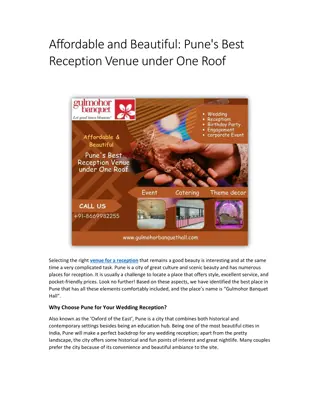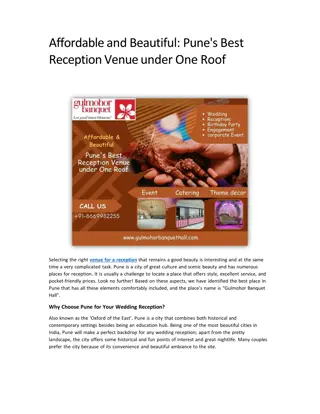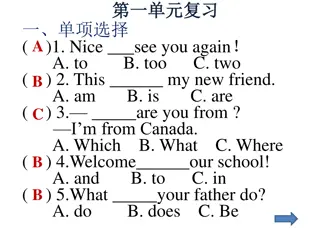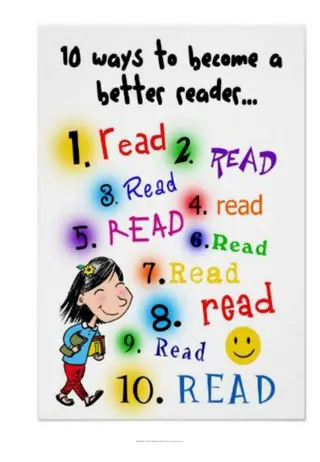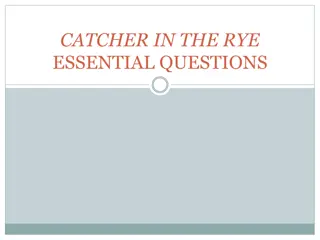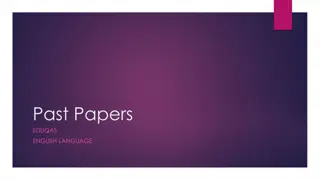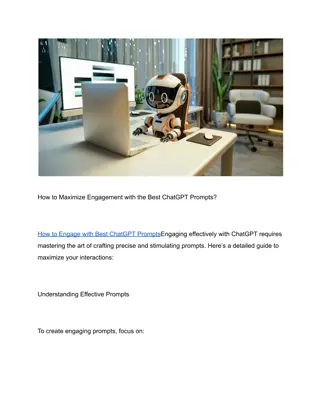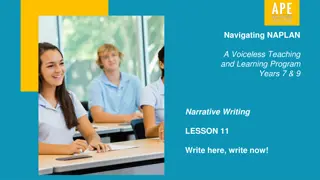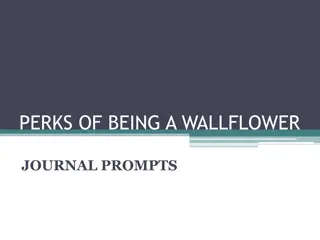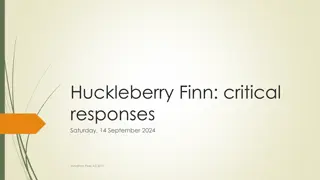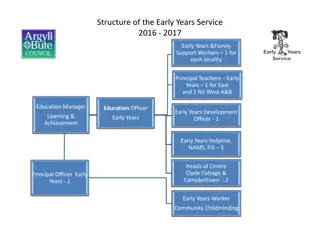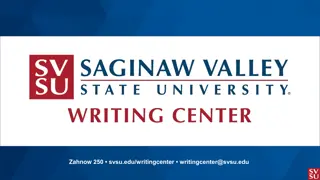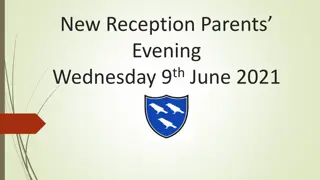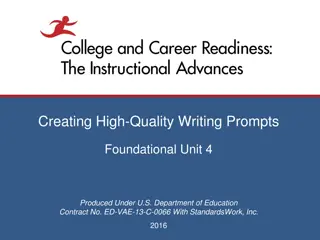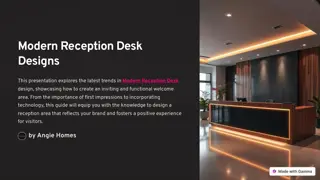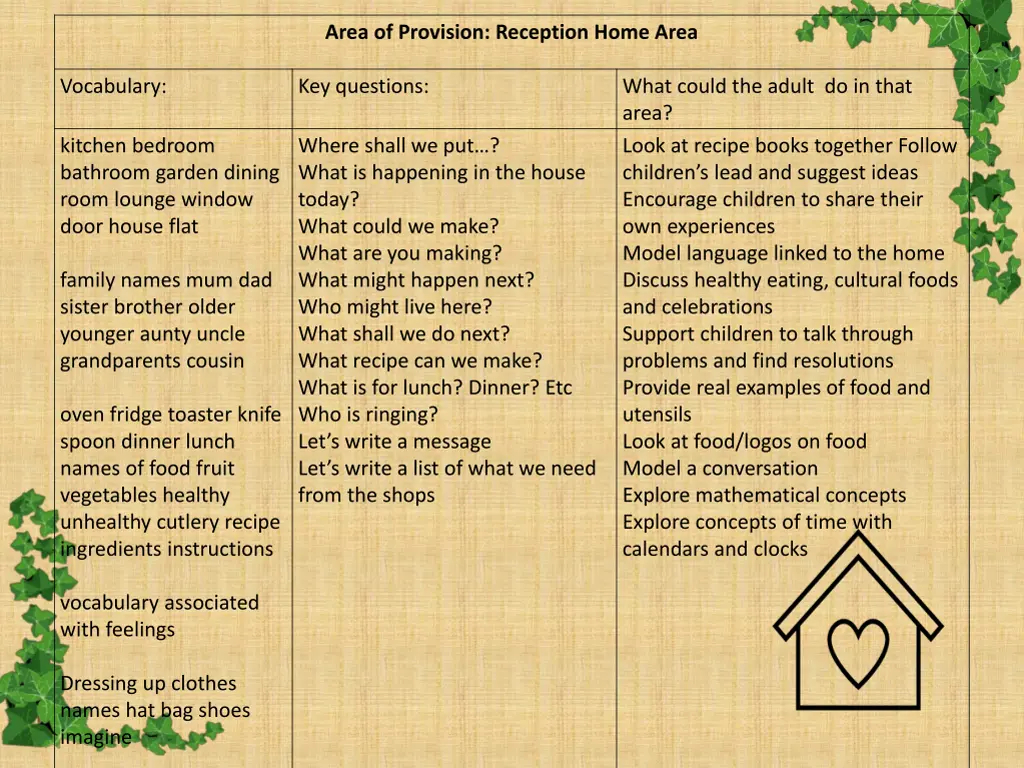
Exploring Home and Construction Areas for Learning
Discover how to enhance children's learning experiences in reception areas focused on home and construction. Engage in activities like cooking, discussing cultural foods, exploring engineering concepts, and fostering creativity through building toys. Encourage language development, problem-solving, and imaginative play in a stimulating environment.
Download Presentation

Please find below an Image/Link to download the presentation.
The content on the website is provided AS IS for your information and personal use only. It may not be sold, licensed, or shared on other websites without obtaining consent from the author. If you encounter any issues during the download, it is possible that the publisher has removed the file from their server.
You are allowed to download the files provided on this website for personal or commercial use, subject to the condition that they are used lawfully. All files are the property of their respective owners.
The content on the website is provided AS IS for your information and personal use only. It may not be sold, licensed, or shared on other websites without obtaining consent from the author.
E N D
Presentation Transcript
Area of Provision: Reception Home Area Vocabulary: Key questions: What could the adult do in that area? Look at recipe books together Follow children s lead and suggest ideas Encourage children to share their own experiences Model language linked to the home Discuss healthy eating, cultural foods and celebrations Support children to talk through problems and find resolutions Provide real examples of food and utensils Look at food/logos on food Model a conversation Explore mathematical concepts Explore concepts of time with calendars and clocks kitchen bedroom bathroom garden dining room lounge window door house flat Where shall we put ? What is happening in the house today? What could we make? What are you making? What might happen next? Who might live here? What shall we do next? What recipe can we make? What is for lunch? Dinner? Etc Who is ringing? Let s write a message Let s write a list of what we need from the shops family names mum dad sister brother older younger aunty uncle grandparents cousin oven fridge toaster knife spoon dinner lunch names of food fruit vegetables healthy unhealthy cutlery recipe ingredients instructions vocabulary associated with feelings Dressing up clothes names hat bag shoes imagine
Area of Provision: Reception Construction Vocabulary: Key questions: What could the adult do in that area? Narrate what the children are doing with the toys Model language and how to build and attach and combine toys together Model writing labels/ signs/instructions Encourage designs before building Model planning Encourage resilience when a structure collapses Provide a descriptive commentary Set challenges to build for a specific purpose Talk about mathematical language Demonstrate how to read maps and discuss positions Share books related to engineering building rood window door chimney wall tall short tallest shortest wide narrow high low horizontal vertical I wonder what would happen if ? How could we make a door for the house?| Why have you built a . ? Why did you choose to use a ? How could we change this? Do you want to change anything? Shall we make a sigh for your model? What could you add to your creation to make it even better? Can you describe the different parts? What could you use/try instead? How could you make it stronger/ taller/wider What shape or size piece will fit here? living toom kitchen bedroom places of workshop bridge arch structure hinger handle system on top of under next to behind beside in on beside make mend fix plan draw write fasten attach connect stack collapse combine slot rotate twist flexible weak rough smooth overhang smooth
Area of Provision: Reception Maths / Loose Parts Vocabulary: Key questions: What could the adult do in that area? Encourage the children to measure by building a range of different buildings of different sixes, height/ length Model how to use scales and extend by promoting language of weight Model using the different materials to encourage interest Use open ended questions to promote thinking Model using mathematical language Provide different representations of numbers for children to explore Demonstrate counting and model counting strategies Draw children s attention to the positions of different objects and introduce new words to describe them number names numerals more less few fewer most equal all together total compare amount count on count backwards add subtract takeaway Subertise What can you tell me about the shape? What shape is this? Can you make a repeating pattern? I wonder if we can make a pattern with shape How can we make 5? Cam you show me a different way? Which number is next? How did you .? Make a house using . Which has more/fewer? Hoe many can you see/find/collect Do you know how many there are all together? Which is heaviest? Lightest? Tallest? Shortest? What do you think will happen if we add one more? Took one away tall short taller shorter tallest shortest long longer longest small big heavy light full empty 2D and 3D shape names side corner faces vertices pattern next continue match sort same different
Area of Provision: Reception Sand Vocabulary: Key questions: What could the adult do in that area? pour fill empty capacity small large more less compare deep shallow bowlful spoonful bucketful1 Can you show me how to ? What happen when we pour the sand Can you fill/empty? Can you find X number1 of gems? How do you write sh for shell? How has the sand changed? Why did that happen?1 How could we . Which tool would work best ? How does the sand feel? How many spoonsful would it take to fil this container? What happens when we do this Describe how much sand is in the container Model how to use the natural materials in the sand in a creative way Model a variety of language and ask opened questions to promote thinking Promote collaborative learning and model conversations Celebrate children s creations and encourage them to discuss how they made it Encourage children to make predictions Which container holds the most? , Will the sandcastle collapse? Why? Present the children with problems to solve that relate to size and capacity, such as Which sized spade will fill the bucket the quickest? or Why does the sand overflow when I pour it into a new container? Explore the impressions left in damp sand from different objects. mould move sculpt scrape level off bowlful excavate mound overflow pinch shell filter texture sieve drop dig lift burry hide pat stamp break gone cover size decorate squeeze scratch gooey sticky slimy grains grainy flat gritty rough. wet dry soggy texture
Area of Provision: Reception Creative Vocabulary: Key questions: What could the adult do in that area? Model how to create something with the different materials Challenge the children to improve their work Introduce children to new materials and techniques over time Explore how materials can change when they get wet Talk about cause and effect Develop and extend maths concepts of maths pattern., shape and size Encourage cooperation and turn taking Provide opportunities to talk about their work with others Provide opportunities for observational drawings join attach cut paint print mix make design stick glue Can you draw/ paint a . Could we work together to make a . How could you make this Show me how you made it Tell your friend how you made it How could I attach these things together? What do I need to paint a picture? What would you like to create? What colours can you use? How can you make that colour? Can you make the colour lighter/darker? How? I wonder if we can make a for a Can we add anything else? How could you improve your model? Decorate smudge blend press light lighter dark darker spread amend adjust texture explore investigate colour names and equipment names cover fold
Area of Provision: Reception Water Vocabulary: Key questions: What could the adult do in that area? pour empty full almost full almost empty wet cold tap tip float sink waterfall deeper faster How many jugs/cups will fill my bucket? How much water would you need? What tools would help you to Is it empty/full? Can you mix it? I wonder if it will float/sink? How can we make bubbles? How do you make a drink? How can I add mote to this container How can we help the . keep the environment clean? Show me how you How could we ? Why did that happen? How could we investigate the best material to make Teddy a coat to keep him dry? What can you see in the water Adult to model the actions labelling the objects in use Introduce different water equipment overtime. Slowly introducing mote challenging resources and containers Invite children to investigate using different tools and to explore the suitability of these for the task in hand Add interesting objects and small world props Present challenges and encourage the children to make predictions Order containers by the amount of liquid they hold Initiate a range of conversations about water. For example, where water comes from, how to use water safely, different uses of water and not being wasteful. Encourage hand-eye coordination by providing resources that encourage pouring and filling in different ways. Splash bubbles whisk, waterproof. trickle, gush flow sprinkle stir dam soak drench moist surface moisture deeper, faster slower evaporate, direction ripple ice melt hot cold transparent opaque transport
Area of Provision: Reception Reading Vocabulary: Key questions: What could the adult do in that area? Title front cover back cover book spine author illustrator illustration fiction nonfiction contents page index blurb glossary What do you think will happen next? Who is that? What are they doing|? Where are they going? How do the characters feel? Why did you choose this book?/ Can you tell me a story|? Which character would you like to be and why? Describe the setting Do you know any of these letters? What does this word say? Can you sound it out? How can we work out what this word is? What type of book this? What do you want to learn more about? Can you out your window around the word Help children to understand what a word is Encourage and model segmenting and blending Draw attention to punctuation Model reading tricky words Discuss characters and what they look like/what their role is in the story Encourage empathy Show how to use the contents page Model how to read a book modelling left to right orientation Explore rhyming words Support children to recognise familiar words Play phonic games Act out stories together using props Model talk for writing visuals Model sequencing a story Once upon a time. Setting character sequence beginning middle end rhyme repetition rhythm who what where when why how Beginning middle end Story mountain Capital letters full stops diagraph trigraph tricky words
Area of Provision: Reception Writing Vocabulary: Key questions: What could the adult do in that area? sound mat sounds finger spaces capital letters segment blend tricky words letters words Can you write about Can you write a sentence, list, letter Label your work with your name Tell me about what you have written Can you show me how to make these marks What other tools could we use? What do these mean? This looks interesting, what does it say? Who are you writing to? What letters do you need to write? What is your writing telling the reader? What sounds can you hear? How could we make this better? Model how to write a letter card etc. Make links with phonic knowledge by modelling segmenting and writing Prompt a child to read/give meaning to their work Model hot to form a letter Introduce a range of mark making tools over time Support and encourage children's early writing Display children s writing Create stories together and scribe what they say Model writing for a variety of purpose Model language for describing different marks Encourage children to give meaning to their marks Provide opportunities for children to share work with others shape pattern book list line letter story instructions postcard language we use from pen pals patter letter and number names alphabet spell describe read reread
Area of Provision: Reception Malleable Vocabulary: Key questions: What could the adult do in that area? chopping board mould roll press cut shape names soft pinch fold squash twist flatten build squish cut out make, mix shape. smooth, soft warm cold, hard shiny dry elastic I wonder how we can halve the playdough How can we decorate the cake? Pie? Tree? Etc Can you make a longer .shorter How did you make this? How has the dough changed? Tell me about your model How can we create a ball? Sausage? Snail? Can you tell your friend how to make your model. Model using the different equipment and the tools safely Challenge the children to make different things Prompt children to explain how they made it Narrate what the children are doing Add different parts to the dough to encourage creativity and things that may change the texture Help children to recognise how playdough is made and work together to make playdough for the malleable area. Provide opportunities for children to share and celebrate their creations. Invite children to create and conduct their own investigations and talk about their findings. Encourage cooperation, turn-taking and sharing resources. Encourage hand-eye coordination by reaching, grasping and manipulating smaller objects. names of different food name of sounds number names To-pical words (diva lamp, snowman, etc) l long short longer shorter scrape smear break apart, sculpt create. halve
Area of Provision: Reception Small World Vocabulary: Key questions: What could the adult do in that area? adventure story farm animals wild animals dinosaurs professions character people feeling words Let s build a house for a . What are the animals doing? Who lives on the farm? Who lives in the jungle? How shall we set up a .? How could we organise? What s this character doing? Can we draw a map of Do you know the story of? What might happen if.. How could you make it even better? What else could you add to that? I can see you are building a bridge. How could you make it strong and secure? Provide a narrative for a story and model sentence starters Include diverse resources and encourage celebrations from a range of cultures Model turn taking Help children to identify the main events in a story and how they can act it out Add non-fiction book to the area to encourage interest Model making outfits for the dolls Look at maps and plans of places and discuss aerial views. Place photos of community and historical buildings. Take time to observe and draw children s attention to how they have changed over time. Ask questions as the children play and explore to develop their thinking and extend language and choices together mend make join change attach assemble nearby positional language and language of size footpath bridleway runway plough soil orbit

